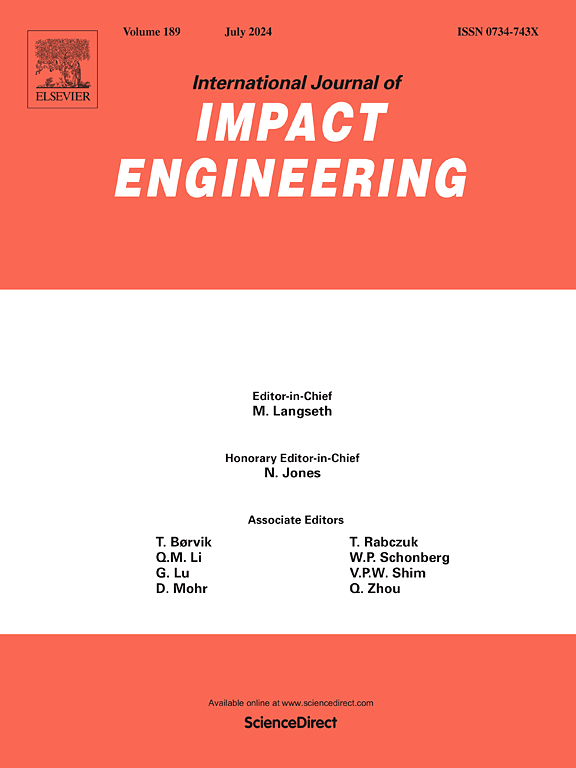基于高速x射线相衬成像的延性破坏现场观察
IF 5.1
2区 工程技术
Q1 ENGINEERING, MECHANICAL
International Journal of Impact Engineering
Pub Date : 2025-04-09
DOI:10.1016/j.ijimpeng.2025.105337
引用次数: 0
摘要
本研究探讨了在低应变率和高应变率的拉伸试验中,增材制造的鳞状合金(Al-Mg-Sc)损伤积累的主要机制。高速x射线相衬成像(XPCI)在欧洲同步辐射设施(ESRF)的ID19光束线上进行,提供实时、高分辨率的内部空洞演化过程可视化,包括空洞成核、生长和合并。这种先进的实验方法有助于精确校准已建立的基于物理的裂缝模型,如Gurson-Tvergaard-Needleman (GTN)模型,否则这些模型依赖于很难通过实验验证的假设。在现场测试期间捕获的2D图像被分割,使用先进的计算技术来识别和跟踪单个空洞。通过移动最小二乘(MLS)方法计算材料内部的应变场,实现了对复杂多变微观结构材料的精确局部应变估计。结果表明,应变速率对孔洞演化有显著影响。在低应变速率下,由于孤立的空洞生长,孔隙率稳定增加。相比之下,高应变率表现出复杂的变形行为,在超过临界应变阈值时,初始空洞生长缓慢转变为快速合并,最终导致广泛的内部损伤。此外,分析了视空洞率的时间导数及其与局部应变速率的关系,揭示了在低应变速率下的成比例损伤演化,表明了空洞的渐进式生长。在高应变率下,表观孔隙率的变化率与局部应变率之间存在较强的线性关系,验证了GTN模型的适用性,并证明了GTN模型在动态加载条件下预测孔隙快速聚合和韧性断裂的能力。本文章由计算机程序翻译,如有差异,请以英文原文为准。
In-situ observation of ductile failure with High-speed X-ray Phase Contrast Imaging
This study investigates the primary mechanisms contributing to damage accumulation in additively manufactured Scalmalloy (Al-Mg-Sc) subjected to tensile tests at low and high strain rates. High-speed X-ray Phase Contrast Imaging (XPCI) performed at beamline ID19 of the European Synchrotron Radiation Facility (ESRF) provide real-time, high-resolution through-volume visualization of internal void evolution processes, including void nucleation, growth, and coalescence. This advanced experimental approach facilitates the precise calibration of established physics-based fracture models, such as the Gurson-Tvergaard-Needleman (GTN) model, which otherwise relies on assumptions that are very difficult to verify experimentally. The 2D images captured during in-situ testing were segmented to identify and track individual voids using advanced computational techniques. The strain fields within the material were calculated via the Moving Least Squares (MLS) method, enabling accurate local strain estimation in materials with complex and evolving microstructures. The results show significant strain rate effects on the void evolution in Scalmalloy. At low strain rates, the void fraction increased steadily as a result of isolated void growth. In contrast, high strain rates demonstrated complex deformation behaviors, with slow initial void growth transitioning to rapid coalescence beyond a critical strain threshold, ultimately resulting in extensive internal damage. Moreover, the analysis of the time derivative of the apparent void fraction and its relationship with the local strain rate reveals proportional damage evolution at low strain rates, indicating progressive void growth. At high strain rates, the strong linear relationships observed between the rate of change of the apparent void fraction and the local strain rate, validate the applicability of the GTN model and demonstrate its ability to predict rapid void coalescence and ductile fracture under dynamic loading conditions.
求助全文
通过发布文献求助,成功后即可免费获取论文全文。
去求助
来源期刊

International Journal of Impact Engineering
工程技术-工程:机械
CiteScore
8.70
自引率
13.70%
发文量
241
审稿时长
52 days
期刊介绍:
The International Journal of Impact Engineering, established in 1983 publishes original research findings related to the response of structures, components and materials subjected to impact, blast and high-rate loading. Areas relevant to the journal encompass the following general topics and those associated with them:
-Behaviour and failure of structures and materials under impact and blast loading
-Systems for protection and absorption of impact and blast loading
-Terminal ballistics
-Dynamic behaviour and failure of materials including plasticity and fracture
-Stress waves
-Structural crashworthiness
-High-rate mechanical and forming processes
-Impact, blast and high-rate loading/measurement techniques and their applications
 求助内容:
求助内容: 应助结果提醒方式:
应助结果提醒方式:


